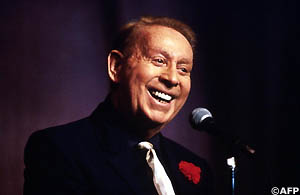Charles Trenet’s underwhelming anniversary
Chanson revolution
Paris
18/02/2011 -

Interestingly, according to a recent survey, the French people’s favourite Trenet song is no longer La Mer, but actually Douce France. When the song was written in 1943, it was already referring to an idealised past – the “Cher pays de mon enfance”, or the dear land of my childhood. One of the charms of the song is that it can be sung sotto voce, and hummed in any musical range, distractedly acting as a nod of recognition between melancholy souls attached to a certain idea of French identity – “My village with its steeple and tidy houses”.
In 2006, the fifth anniversary of Trenet’s death coincided with the release of Je n’irai pas à Notre-Dame, an album of previously unpublished songs recorded between 1994 and 1999, the period of his last recordings. There are no such events this year, apart from a few re-releases and a new book by Jacques Pessis, a journalist close to the singer who has published a tender, enthusiastic biography, Trenet, le philosophe du bonheur (240 pages, L’Archipel).
The media and record houses are focusing their efforts on the twentieth anniversary of Serge Gainsbourg’s death and the thirtieth anniversary of the death of George Brassens. The reasons are not only commercial – it appears that France is slowly losing its grip on a whole slice of its singing past.
Bringing generations together

In the France of the eighties, which was soon to see a law fixing French language quotas on the radio, Charles Trenet embodied the link between several different generations of artists. The way he revolutionised swing in his youth was an absolute reference for artists trying to find new musical idioms for the French language.
When, at the dawn of a new millennium, that big kid Jacques Higelin decided to explore his repertoire and his memory with a tour and disc completely devoted to Trenet, he himself recognized that it was a return to the roots of his deep-set passion for upset, daring and poetry.
Jacques Brel summed it up back in the fifties when he said, “If it weren’t him, we’d all be accountants”. Serge Gainsbourg was bowled over by Trenet when he was nine or ten; Georges Brassens imitated him in thousands of draft songs before hitting on his own style; it was “The Good Lord (…) up on his armchair of clouds” in Boum that won over Anne Sylvestre to the charms of song and poetry; and Jacques Higelin first got up on stage as a ten-year-old to sing Trenet.
Freedom and fantasy
Charles Trenet gave French chanson the capacity to dream out loud. When he sang his Y a d’la joie to Maurice Chevalier, the latter discovered new joy in the third verse: “The Eiffel Tower has gone walking/She’s gone and jumped straight into the Seine”. Never before had there been such freedom, fantasy and folly in the land of “forever-love” and “tender-caress”.
What was so new about Trenet was not just importing jazz: for about fifteen years, Maurice Chevalier had regularly been bringing music back from the other side of the Atlantic and, since the early thirties, Mireille, Pills and Tabet and Jean Sablon had also been playing with the syncopated and lively rhythms of jazz. But Trenet had done something completely different, which was the way he associated the energy of that swing with such totally free poetic inspiration. Objects, places, people and images were uprooting, new and astounding – in his songs the Eiffel Tower goes walking, funny phantoms appear, lovers float in the air, and statues come to life.
He gave song a childhood. Perhaps that’s why he is not being celebrated with such obvious gusto this year. French pop music is currently stripping itself bare of childhood: folk songs in English, electro out for dance floor glory, rock music proud of its electricity – there are few movements right now that resemble Trenet’s happy poetry and fantasy.
Paradoxically, you get the impression that after liberating so many teenagers from the burdens of the adult world, Charles Trenet has now gone to take refuge in children’s bedrooms, where hearts still go “boum” and the taxman never sets foot. Perhaps the kids are the only ones left who can still dream like Charles Trenet.
Bertrand Dicale
20/02/2006 -
21/10/2002 -
17/05/1999 -













